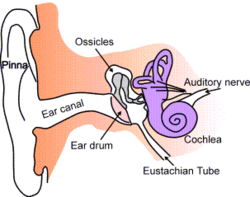shasty
100+ Head-Fier
- Joined
- Jan 3, 2006
- Posts
- 316
- Likes
- 1
I had a coincidental revelation today, and I'm wondering if this may apply to other head-fi members using iem's.
Whenever I plugged my ER4P's deep in my ears, I would always feel a buildup of air pressure in my ears against the earphones, which made sense because the earphones compressed the air inside the ear as it was pushed in and completely blocked out airflow. This feeling was a bit uncomfortable, but I didn't think I could do anything about it.
But today, the pressure was especially annoying and I used a technique I learned to get rid of the pressure when there's a sudden change of altitude in airplanes and other cases. I held my nose and tried to push the air out of my ears by attempting to breathe out of my nose (the air can't get out of the nose so it tries get out of the ears and relieves the air pressure).
While doing this, I noticed a great change on the sound signature:the relieving of the air pressure opened up the sound considerably and the mids and treble became much more lively. Of course, when I stopped doing the technique, the air pressure normalized because the air still was trapped in my ears. This got me thinking, and I attempted the technique right before and as I was plugging in the earphones to get the air out of my ears so it wouldn't be compressed and build up pressure.
The results were fantastic, ER-4P's sounded much more crisp and detailed than before although bass response remained the same as well as both bass and treble extension. I'm enjoying the new sound alot, even though I probably look ridiculous holding my nose and plugging in the earphones at the same time. I'm wondering if anyone else has this problem regarding iems.
Whenever I plugged my ER4P's deep in my ears, I would always feel a buildup of air pressure in my ears against the earphones, which made sense because the earphones compressed the air inside the ear as it was pushed in and completely blocked out airflow. This feeling was a bit uncomfortable, but I didn't think I could do anything about it.
But today, the pressure was especially annoying and I used a technique I learned to get rid of the pressure when there's a sudden change of altitude in airplanes and other cases. I held my nose and tried to push the air out of my ears by attempting to breathe out of my nose (the air can't get out of the nose so it tries get out of the ears and relieves the air pressure).
While doing this, I noticed a great change on the sound signature:the relieving of the air pressure opened up the sound considerably and the mids and treble became much more lively. Of course, when I stopped doing the technique, the air pressure normalized because the air still was trapped in my ears. This got me thinking, and I attempted the technique right before and as I was plugging in the earphones to get the air out of my ears so it wouldn't be compressed and build up pressure.
The results were fantastic, ER-4P's sounded much more crisp and detailed than before although bass response remained the same as well as both bass and treble extension. I'm enjoying the new sound alot, even though I probably look ridiculous holding my nose and plugging in the earphones at the same time. I'm wondering if anyone else has this problem regarding iems.














